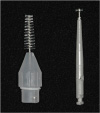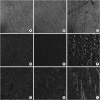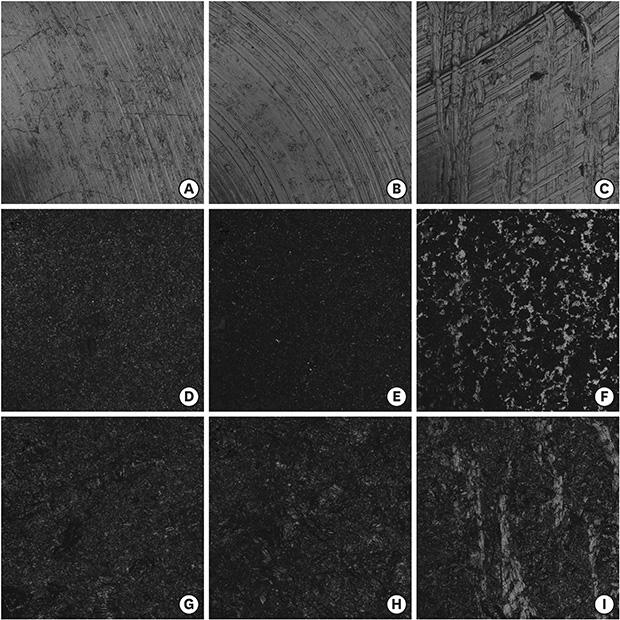1. Zitzmann NU, Berglundh T. Definition and prevalence of peri-implant diseases. J Clin Periodontol. 2008; 35:286–291.

2. Mombelli A, Lang NP. The diagnosis and treatment of peri-implantitis. Periodontol 2000. 1998; 17:63–76.

3. Quirynen M, van der Mei HC, Bollen CM, Schotte A, Marechal M, Doornbusch GI, et al. An
in vivo study of the influence of the surface roughness of implants on the microbiology of supra- and subgingival plaque. J Dent Res. 1993; 72:1304–1309.

4. Rimondini L, Farè S, Brambilla E, Felloni A, Consonni C, Brossa F, et al. The effect of surface roughness on early
in vivo plaque colonization on titanium. J Periodontol. 1997; 68:556–562.

5. Bollen CM, Lambrechts P, Quirynen M. Comparison of surface roughness of oral hard materials to the threshold surface roughness for bacterial plaque retention: a review of the literature. Dent Mater. 1997; 13:258–269.

6. Bollen CM, Papaioanno W, Van Eldere J, Schepers E, Quirynen M, van Steenberghe D. The influence of abutment surface roughness on plaque accumulation and peri-implant mucositis. Clin Oral Implants Res. 1996; 7:201–211.

7. Quirynen M, Bollen CM, Papaioannou W, Van Eldere J, van Steenberghe D. The influence of titanium abutment surface roughness on plaque accumulation and gingivitis: short-term observations. Int J Oral Maxillofac Implants. 1996; 11:169–178.
8. Alhag M, Renvert S, Polyzois I, Claffey N. Re-osseointegration on rough implant surfaces previously coated with bacterial biofilm: an experimental study in the dog. Clin Oral Implants Res. 2008; 19:182–187.

9. Park JB, Jang YJ, Choi BK, Kim KK, Ko Y. Treatment with various ultrasonic scaler tips affects efficiency of brushing of SLA titanium discs. J Craniofac Surg. 2013; 24:e119–23.

10. Park JB, Jang YJ, Koh M, Choi BK, Kim KK, Ko Y.
In vitro analysis of the efficacy of ultrasonic scalers and a toothbrush for removing bacteria from resorbable blast material titanium disks. J Periodontol. 2013; 84:1191–1198.

11. Park JB, Kim N, Ko Y. Effects of ultrasonic scaler tips and toothbrush on titanium disc surfaces evaluated with confocal microscopy. J Craniofac Surg. 2012; 23:1552–1558.

12. Wohlfahrt JC, Lyngstadaas SP. Mechanical debridement of a peri-implant osseous defect with a novel titanium brush and reconstruction with porous titanium granules: a case report with reentry surgery. Clin Adv Periodontics. 2012; 2:136–140.

13. Schmidt KE, Auschill TM, Heumann C, Frankenberger R, Eick S, Sculean A, et al. Clinical and laboratory evaluation of the effects of different treatment modalities on titanium healing caps: a randomized, controlled clinical trial. Clin Oral Investig. 2018; 22:2149–2160.

14. Bertoldi C, Lusuardi D, Battarra F, Sassatelli P, Spinato S, Zaffe D. The maintenance of inserted titanium implants:
in-vitro evaluation of exposed surfaces cleaned with three different instruments. Clin Oral Implants Res. 2017; 28:57–63.

15. Chen CJ, Ding SJ, Chen CC. Effects of surface conditions of titanium dental implants on bacterial adhesion. Photomed Laser Surg. 2016; 34:379–388.

16. Sahrmann P, Ronay V, Hofer D, Attin T, Jung RE, Schmidlin PR.
In vitro cleaning potential of three different implant debridement methods. Clin Oral Implants Res. 2015; 26:314–319.

17. Fox SC, Moriarty JD, Kusy RP. The effects of scaling a titanium implant surface with metal and plastic instruments: an
in vitro study. J Periodontol. 1990; 61:485–490.

18. Homiak AW, Cook PA, DeBoer J. Effect of hygiene instrumentation on titanium abutments: a scanning electron microscopy study. J Prosthet Dent. 1992; 67:364–369.

19. Rühling A, Kocher T, Kreusch J, Plagmann HC. Treatment of subgingival implant surfaces with Teflon-coated sonic and ultrasonic scaler tips and various implant curettes. An
in vitro study. Clin Oral Implants Res. 1994; 5:19–29.

20. Meschenmoser A, d’Hoedt B, Meyle J, Elssner G, Korn D, Hämmerle H, et al. Effects of various hygiene procedures on the surface characteristics of titanium abutments. J Periodontol. 1996; 67:229–235.

21. Schmage P, Thielemann J, Nergiz I, Scorziello TM, Pfeiffer P. Effects of 10 cleaning instruments on four different implant surfaces. Int J Oral Maxillofac Implants. 2012; 27:308–317.
22. Mengel R, Meer C, Flores-de-Jacoby L. The treatment of uncoated and titanium nitride-coated abutments with different instruments. Int J Oral Maxillofac Implants. 2004; 19:232–238.
23. Louropoulou A, Slot DE, Van der Weijden FA. Titanium surface alterations following the use of different mechanical instruments: a systematic review. Clin Oral Implants Res. 2012; 23:643–658.

24. Evans AR, Harper IS, Sanson GD. Confocal imaging, visualization and 3-D surface measurement of small mammalian teeth. J Microsc. 2001; 204:108–118.

25. Howell K, Hopkins N, Mcloughlin P. Combined confocal microscopy and stereology: a highly efficient and unbiased approach to quantitative structural measurement in tissues. Exp Physiol. 2002; 87:747–756.

26. Kwan JY, Zablotsky MH, Meffert RM. Implant maintenance using a modified ultrasonic instrument. J Dent Hyg. 1990; 64:422.
27. Rapley JW, Swan RH, Hallmon WW, Mills MP. The surface characteristics produced by various oral hygiene instruments and materials on titanium implant abutments. Int J Oral Maxillofac Implants. 1990; 5:47–52.
28. Rimondini L, Cicognani Simoncini F, Carrassi A. Micro-morphometric assessment of titanium plasma-sprayed coating removal using burs for the treatment of peri-implant disease. Clin Oral Implants Res. 2000; 11:129–138.

29. Rühling A, Hellweg A, Plagmann HC, Kocher T. Removal of HA and TPS implant coatings and fibroblast attachment on exposed surfaces. Clin Oral Implants Res. 2001; 12:301–308.

30. Barbour ME, O'Sullivan DJ, Jenkinson HF, Jagger DC. The effects of polishing methods on surface morphology, roughness and bacterial colonisation of titanium abutments. J Mater Sci Mater Med. 2007; 18:1439–1447.

31. Duarte PM, Reis AF, de Freitas PM, Ota-Tsuzuki C. Bacterial adhesion on smooth and rough titanium surfaces after treatment with different instruments. J Periodontol. 2009; 80:1824–1832.

32. Schwarz F, Papanicolau P, Rothamel D, Beck B, Herten M, Becker J. Influence of plaque biofilm removal on reestablishment of the biocompatibility of contaminated titanium surfaces. J Biomed Mater Res A. 2006; 77A:437–444.

33. Bailey GM, Gardner JS, Day MH, Kovanda BJ. Implant surface alterations from a nonmetallic ultrasonic tip. J West Soc Periodontol Periodontal Abstr. 1998; 46:69–73.








 PDF
PDF ePub
ePub Citation
Citation Print
Print




 XML Download
XML Download